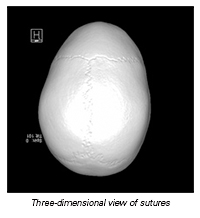Children's Emergency Department is now located in Children's Tower: 1001 E. Marshall Street.
Learn moreThere are minimally invasive surgery options for many conditions, including craniosynostosis.

This option has been available for more than 20 years as an alternative to the traditional or open procedure, with benefits including a smaller incision, less blood loss, less discomfort and swelling and a much shorter hospital stay. The cosmetic outcomes are excellent.
Craniosynostosis occurs during the formation of the baby in the mother's womb. It is a condition where the sutures of the baby's head are not open, but rather "fused." Sutures are spaces between the bone plates of the skull. They allow for the rapid growth of the brain and the skull in the first year of life.
Sagittal craniosynostosis is the most common form. It is caused when the sagittal suture is closed. This suture is the one that runs from the location of the soft spot or fontanelle to the back of the head. It causes the head to look long and narrow. The forehead and/or the back may look more round and full when you look at the baby's head from the side. Portions of or the entire suture may be closed. The soft spot may be open or closed.
View more Sagittal Craniosynostosis images.
Metopic craniosynostosis is when the metopic suture is closed. This suture runs from the location of the soft spot down to the area between the eyes. This will cause the baby to have a pointy forehead when you are looking down on the baby. The soft spot may be opened or closed.
Coronal craniosynostosis is when the suture on the side of the head is closed. It runs from the side of the eye up to the soft spot. The forehead will be flat on that side and the eye socket may look further back. The soft spot may be opened or closed.
View more Coronal Craniosynostosis images.
Lambdoid craniosynostosis is very uncommon. This occurs when the suture on the back of the head is fused. It runs from behind the ear to the back of the head. It will cause the baby's ear to be pulled back, a bulge behind the ear and flatness over the suture.


